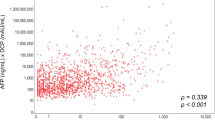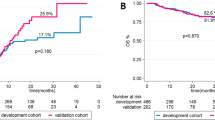Abstract
Background
We assessed the prognostic impact of the ADV score (α-fetoprotein [AFP]–des-γ-carboxyprothrombin [DCP]–tumor volume [TV] score) for predicting hepatocellular carcinoma (HCC) recurrence and patient survival after living donor liver transplantation (LDLT).
Methods
This study included 843 HCC patients who underwent LDLT between January 2006 and December 2015 at Asan Medical Center. These cases were divided into treatment-naïve (TN, n = 256]) and pretransplant-treated (PT, n = 587 [69.6%]) groups.
Results
There were weak or nearly no correlations among AFP, DCP, and TV. There existed high correlations between the pretransplant and explant findings regarding tumor number, size, and ADV score. Right lobe grafts were implanted in 760 (90.2%) patients. HCC recurrence and all-cause patient death occurred in 182 (15.9%) and 126 (15.0%) respectively during the follow-up period for 75.6 ± 35.5 months. The 5-year tumor recurrence (TR) and overall patient survival (OS) rates were 21.5% and 86.2%, respectively. The PT group showed higher TR (p < 0.001) and lower OS rates (p < 0.001). TR and OS were closely correlated with both pretransplant and explant ADV scores in the TN and PT groups. The ADV score enabled further prognostic stratification of the patients within and beyond the Milan, UCSF, and Asan Medical Center criteria. Compared with the 7 pre-existing selection criteria, ADV score with a cutoff of 5log showed the highest prognostic contrast regarding TR and OS.
Conclusions
Our prognostic prediction model using ADV scores is an integrated quantitative surrogate biomarker for posttransplant prognosis in HCC patients and can provide reliable information that assists the decision-making for LDLT.





Similar content being viewed by others
Abbreviations
- AFP:
-
α-fetoprotein
- DCP:
-
des-γ-carboxyprothrombin
- TV:
-
Tumor volume
- ADV score:
-
Multiplication of AFP, DCP, and TV
- AD score:
-
Multiplication of AFP and DCP
- AMC:
-
Asan Medical Center
- HCC:
-
Hepatocellular carcinoma
- LDLT:
-
Living donor liver transplantation
- LT:
-
Liver transplantation
- mRECIST:
-
Modified Response Evaluation Criteria In Solid Tumors
- PT:
-
Pretransplant-treated
- TN:
-
Treatment-naïve
- UCSF:
-
University of California San Francisco
References
Mazzaferro V, Regalia E, Doci R, Andreola S, Pulvirenti A, Bozzetti F, et al. Liver transplantation for the treatment of small hepatocellular carcinomas in patients with cirrhosis. New Engl J Med 1996;334:693–699.
Yao FY, Ferrell L, Bass NM, Watson JJ, Bacchetti P, Venook A, et al. Liver transplantation for hepatocellular carcinoma: Expansion of the tumor size limits does not adversely impact survival. Hepatology 2001;33:1394–1403.
Lee SG, Hwang S, Moon DB, Ahn CS, Kim KH, Sung KB, et al. Expanded indication criteria of living donor liver transplantation for hepatocellular carcinoma at one large-volume center. Liver Transpl 2008;14:935–945.
Toso C, Asthana S, Bigam DL, Shapiro AM, Kneteman NM. Reassessing selection criteria prior to liver transplantation for hepatocellular carcinoma utilizing the Scientific Registry of Transplant Recipients database. Hepatology 2009;49:832–838.
Fujiki M, Takada Y, Ogura Y, Oike F, Kaido T, Teramukai S, et al. Significance of des-gamma-carboxy prothrombin in selection criteria for living donor liver transplantation for hepatocellular carcinoma. Am J Transplant 2009;9:2362–2371.
Mazzaferro V, Llovet JM, Miceli R, Bhoori S, Schiavo M, Mariani L, et al. Predicting survival after liver transplantation in patients with hepatocellular carcinoma beyond the Milan criteria: a retrospective, exploratory analysis. Lancet Oncol 2009;10:35–43.
Hwang S, Song GW, Lee YJ, Kim KH, Ahn CS, Moon DB, et al. Multiplication of tumor volume by two tumor markers is a post-resection prognostic predictor for solitary hepatocellular carcinoma. J Gastrointest Surg 2016;20:1807–1820.
Jung DH, Hwang S, Lee YJ, Kim KH, Song GW, Ahn CS, et al. Small hepatocellular carcinoma with low tumor marker expression benefits more from anatomical resection than tumors with aggressive biology. Ann Surg 2019;269:511–519.
Hwang S, Joh JW, Wang HJ, Kim DG, Kim KS, Suh KS, et al. Prognostic prediction models for resection of large hepatocellular carcinoma: A Korean multicenter study. World J Surg 2018;42:2579–2591.
Ha SM, Hwang S, Park JY, Lee YJ, Kim KH, Song GW, et al. Validation of the OncoHepa test, a multigene expression profile test, and the tumor marker-volume score to predict postresection outcome in small solitary hepatocellular carcinomas. Ann Surg Treat Res 2018;95:303–311.
Hwang S, Moon DB, Ahn CS, Kim KH, Ha TY, Song GW, et al. Risk-based long-term screening for hepatocellular carcinoma recurrence after living donor liver transplantation. Transplant Proc 2013;45:3076–3084.
Alshahrani AA, Ha SM, Hwang S, Ahn CS, Kim KH, et al. Clinical features and surveillance of very late hepatocellular carcinoma recurrence after liver transplantation. Ann Transplant 2018;23:659–665.
The Korean Association for the Study of the Liver (KASL). KASL clinical practice guidelines: management of chronic hepatitis B. Clin Mol Hepatol 2016;22:18–75.
Jung DH, Tak E, Hwang S, Song GW, Ahn CS, Kim KH, et al. Antitumor effect of sorafenib and mammalian target of rapamycin inhibitor in liver transplantation recipients with hepatocellular carcinoma recurrence. Liver Transpl 2018;24:932–945.
Hwang S, Kim YH, Kim DK, Ahn CS, Moon DB, Kim KH, et al. Resection of pulmonary metastases from hepatocellular carcinoma following liver transplantation. World J Surg 2012;36:1592–1602.
Lencioni R, Llovet JM. Modified RECIST (mRECIST) assessment for hepatocellular carcinoma. Semin Liver Dis 2010; 30:52–60.
Kim HD, Shim JH, Kim GA, Shin YM, Yu E, Lee SG, et al. Optimal methods for measuring eligibility for liver transplant in hepatocellular carcinoma patients undergoing transarterial chemoembolization. J Hepatol 2015;62:1076–1784.
Galizia MS, Töre HG, Chalian H, Yaghmai V. Evaluation of hepatocellular carcinoma size using two-dimensional and volumetric analysis: effect on liver transplantation eligibility. Acad Radiol 2011;18:1555–60.
Mazzaferro V, Sposito C, Zhou J, Pinna AD, De Carlis L, Fan J, et al. Metroticket 2.0 model for analysis of competing risks of death after liver transplantation for hepatocellular carcinoma. Gastroenterology 2018;154:128–139.
Otto G, Herber S, Heise M, Lohse AW, Mönch C, Bittinger F, et al. Response to transarterial chemoembolization as a biological selection criterion for liver transplantation in hepatocellular carcinoma. Liver Transpl 2006;12:1260–1267.
Sandow TA, Arndt SE, Albar AA, DeVun DA, Kirsch DS, Gimenez JM, et al. Assessment of response to transcatheter arterial chemoembolization with doxorubicin-eluting microspheres: tumor biology and hepatocellular carcinoma recurrence in a 5-year transplant cohort. Radiology 2018;286:1072–1083.
Kang WH, Hwang S, Song GW, Lee YJ, Kim KH, Ahn CS, et al. Prognostic effect of transarterial chemoembolization-induced complete pathological response in patients undergoing liver resection and transplantation for hepatocellular carcinoma. Liver Transpl 2017;23:781–790.
Botea F, Marconi M, Lutman F, Balzarini L, Roncalli M, Montorsi M, et al. Radiological estimation of size in colorectal liver metastases: is it reliable? Comparison with post-resectional measurements. Updates Surg 2010;62:21–26.
Hwang S, Ahn CS, Kim KH, Moon DB, Ha TY, Song GW, et al. Super-selection of a subgroup of hepatocellular carcinoma patients at minimal risk of recurrence for liver transplantation. J Gastrointest Surg 2011;15:971–981.
Author information
Authors and Affiliations
Corresponding author
Ethics declarations
Conflict of Interest
The authors declare no competing interests.
Additional information
Publisher’s Note
Springer Nature remains neutral with regard to jurisdictional claims in published maps and institutional affiliations.
Supplementary Information
ESM 1
(DOCX 54 kb)
Rights and permissions
About this article
Cite this article
Hwang, S., Song, GW., Ahn, CS. et al. Quantitative Prognostic Prediction Using ADV Score for Hepatocellular Carcinoma Following Living Donor Liver Transplantation. J Gastrointest Surg 25, 2503–2515 (2021). https://doi.org/10.1007/s11605-021-04939-w
Received:
Accepted:
Published:
Issue Date:
DOI: https://doi.org/10.1007/s11605-021-04939-w




